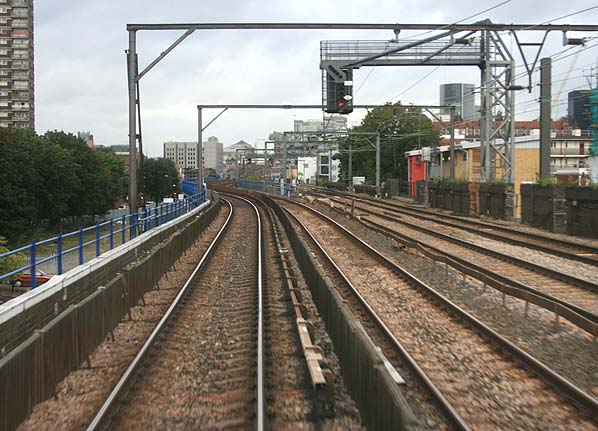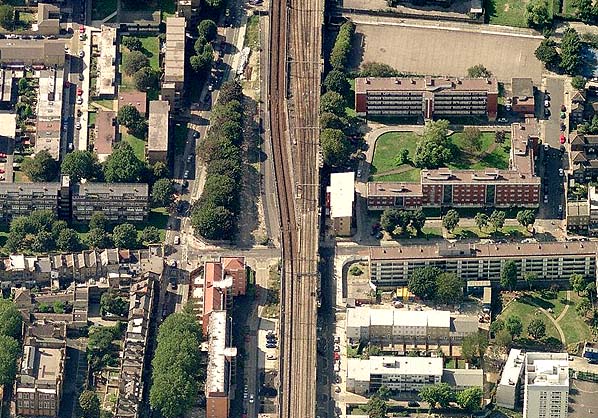|
Notes: Cannon Street Road was not one of the original stations on the London & Blackwall Railway first appearing in timetable in September 1842, two years after the line opened. It was very short lived and last appeared in the timetable in December 1848. No photographs are known to exist.
BRIEF HISTORY OF THE LONDON & BLACKWALL RAILWAY
The London & Blackwall Railway was one of London's earliest railways and was unusual in that it was operated by cable haulage for the first nine years. Initially two companies proposed a rail link from the City to the docks and residential developments along the north bank of the Thames. George Stephenson's Commercial Railway received Parliamentary sanction to build the line on the 28th July 1836 and in 1839 subsequently changed its name to the London & Blackwall Railway.
Despite opposition from the Corporation of London, a terminus at Fenchurch Street was eventually approved. At the Blackwall end of the line a station and adjacent pier (Brunswick Wharf) were to be built on land owned by the East & West India Dock; by this time the company had changed its name to the London & Blackwall Railway. As there were no plans for a direct connection with any other lines the L & B opted for cable haulage with a gauge of about 5' (exact gauge not recorded).
Although the route was only 3 1/2 miles long six intermediate stations were proposed at Minories, Shadwell, Stepney, Limehouse, West India Dock and Poplar with a further short lived station at Cannon Street Road opening in 1842 (it closed four years later). From Minories to West India Dock the line was carried on a brick viaduct which then gave way to an embankment with the line eventually completed its journey through Poplar in a cutting.
The engines to drive the cable winding gear were located a short distance from each of the terminals, at Minories at the London end and about 350 yards from the Blackwall terminus. From the cable houses there was an upwards gradient to slow down arriving trains and enable departing trains to run to the winding station under their own impetus. Each of the two tracks had its own hemp rope some seven miles in length.
The Blackwall Railway opened on 6th July 1840 when the first of the two lines between Minories and Blackwall was opened with the second track coming into use on 3rd August providing a 15 minute interval service. Passenger numbers were however disappointing; it was hoped that this would improve when the extension into Fenchurch Street was opened on 2nd August 1841 but there was little change. There were teething problems with the ropes which regularly broke and in 1841 new wire ropes were fitted but they were over twice the weight.
From the outset, the hopes of the railway company had been largely founded on capturing passenger traffic from horse busses and river carriers. In 1841 a ferry from Woolwich - Brunswick Wharf was introduced which brought an immediate increase in passenger receipts as, at that time, Woolwich had no rail connection into the City but this gradually eroded as the expansion of the rail network south of the river soon brought a more convenient route into London. The wharf was not confined to local journeys with steamers serving towns along the Kent coast with other services crossing the Channel to Antwerp and Rotterdam.
The L & B eventually sought new partners to increase revenue with several schemes being promoted. The East & West India Docks & Birmingham Junction Railway (later to become the North London Railway) proposed a line from the L & NWR at Camden to Poplar and eventually it was decided that this should run into the Fenchurch Street terminus via a connection at Bow. This scheme required a change of gauge and conversion to steam haulage for the L & B and the extension from Stepney - Bow opened on 2nd April 1849. By the beginning of 1854 the Eastern Counties Railway were running trains into the City terminus from their Enfield, Hertford and Brentwood lines; the two companies jointly established the London, Tilbury & Southend Railway which opened on the 13th April 1854.
The L & B continued to expand with some Eastern Counties trains on their North Woolwich line running into an enlarged Blackwall terminus. A third line between Stepney and Fenchurch Street was added after completion of a connection with the Tilbury line at Barking, this opened on 31st March 1858 allowing Tilbury & Southend trains to run directly into Fenchurch Street which was preferred by the ECR due the limited accommodation at their own Bishopsgate terminus. This continued until the opening of Liverpool Street in 1874.
Developments on the revitalised Blackwall Railway were not confined to passenger traffic. In 1852 a junction was constructed at Poplar between the North London line and the L. & B. which was used for traffic between the former and the East India Dock. To further accommodate freight traffic a short branch was opened to Haydon Square at the City end of the line. In 1858 a goods depot named Royal Mint Street opened on the site of Minories Station which had closed in 1853 and the Midland Railway's City Goods was also opened nearby. In 1861 a new depot was built for ECR, LTS and Blackwall traffic on the north side of the line just outside Fenchurch Street. Finally in 1864 a short branch was opened to serve the London and St. Katherines Docks.
There is no doubt that the decision by the London & Blackwall Railway to abandon cable haulage in favour of conventional locomotive working was the right one and this was reflected in the company's dividends which, by 1862, had risen to a steady 3%.
In 1865 a Parliamentary Act approved the lease of the Blackwall line to the newly-formed Great Eastern Railway. The importance of Fenchurch Street to the GER ensured a good price for the Blackwall shareholders who continued to receive a guarantee dividend of 4 1/2% until the line became part of the LNER in 1923.
On 19th June 1865 the London & Blackwall Company obtained an Act that authorised the building a line from a junction with the London & Blackwall at what was to become Millwall Junction Station across the Isle of Dogs to a terminus at North Greenwich. Progress on the line was slow opening as far as Millwall Dock Station on the 18th December 1871 and reaching North Greenwich on the 29th July 1872.
Although the North London Railway had originally been the Blackwall Company's main partner so far as passenger traffic was concerned, as more Eastern Counties, and later Great Eastern, trains came to use Fenchurch Street, the North London traffic had diminished in relative importance. This feature may well have influenced the North London Company in its decision to build their own terminus at Broad Street which opened on 1st November 1865 but to compensate for loss of traffic the North London extended their Poplar service to Blackwall on the 1st September 1868, this was however short lived as the service was cut back to Poplar again in 1890.
In 1872 new stations opened at Leman Street and Millwall Junction and in 1893 approval was granted for a further widening of the busiest section of the line between Fenchurch Street and Stepney to four tracks. The GER attempted to buy the Blackwall line outright in 1898 but this was rejected.
 |
Soon after the turn of the century the tide began to turn against the railway's passenger traffic to Blackwall. Much of the steamer traffic on the Thames had succumbed to railway competition and already people were moving further out of London to live. In 1907, the Blackwall line service was reduced to three trains an hour, and in the October of the following year Sunday services were discontinued. The number of passengers using the line east of Stepney continued to diminish and closure came on the 3rd May 1926, at the time of the General Strike. By this date the old London & Blackwall Railway had ceased to exist, being absorbed in the London & North Eastern Railway as part of the grouping resulting from the Railways Act of 1921.
The section of the original Blackwall line between Fenchurch Street and Stepney was not affected by the 1926 closure and continued to carry a heavy volume of traffic. The intermediate stations, which had platforms only on the original pair of tracks, were closed in 1941 but this portion of the line is today intensively used by the electrified service to Southend and Tilbury and the later Dockland Light Railway.
Freight traffic continued on the Blackwall route and Millwall Junction Station remained open for freight traffic until 14th November 1927. The line remained in use for freight particularly via Limehouse curve with many trains carrying Elder & Fyfe banana traffic from their facility on the south side of the East India Docks. The first section of track to be lifted was at the Blackwall end where the station was demolished in 1946 to make way for Brunswick power station. The last train between Stepney Junction and Limehouse was an enthusiasts special on 14th April 1951. After that date the points at the west end were disconnected with access to the Blackwall line remaining via the Limehouse Curve. The curve was abandoned on 10th May 1963 leaving the only access via the North London line at Poplar. This remained in use until at least 1976 but by the early 1980's all the track had been lifted.
In December 1982 Government approval was given for the Docklands Light Railway which would utilise the London & Blackwall line between Minories and Poplar. The DLR opened on 31st August 1987; the remaining section of line through Millwall Junction was lost under a new road development in the early 1990’s which opened in 1993 as Aspen Way.
Sources: The London & Blackwall Railway by Geoffrey Body & Robert. E. Eastleigh. Trans-Rail Publications 1964
Stepney's Own Railway - A history of the London & Blackwall System by J.E.Connor, Connor & Butler 1984 & 1987 ISBN 0 947699 02 3
Route map drawn by Alan Young
For other stations on the London & Blackwall Railway click on the station name: Fenchurch Street, Minories, Leman Street, Shadwell & St. Georges's East, Stepney East, Limehouse, West India Docks, Millwall Junction, Poplar (1st site), Poplar (2nd site) & Blackwall
See also London & Blackwall Viaduct & Limehouse Curve
|




 Home Page
Home Page 
